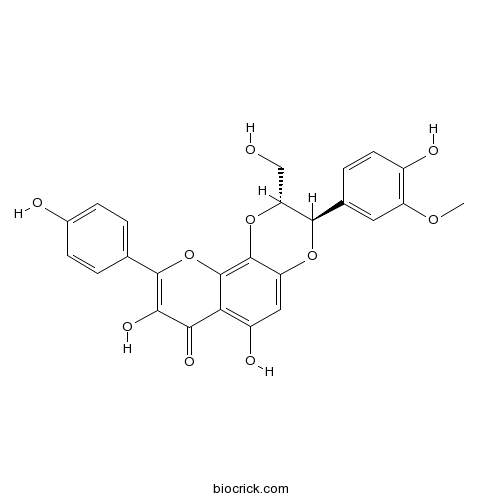RhodiolinCAS# 86831-53-0 |

Quality Control & MSDS
3D structure
Package In Stock
Number of papers citing our products

| Cas No. | 86831-53-0 | SDF | Download SDF |
| PubChem ID | 14778358 | Appearance | Powder |
| Formula | C25H20O10 | M.Wt | 480.4 |
| Type of Compound | N/A | Storage | Desiccate at -20°C |
| Solubility | Soluble in Chloroform,Dichloromethane,Ethyl Acetate,DMSO,Acetone,etc. | ||
| Chemical Name | (2R,3R)-6,8-dihydroxy-3-(4-hydroxy-3-methoxyphenyl)-2-(hydroxymethyl)-9-(4-hydroxyphenyl)-2,3-dihydropyrano[3,2-h][1,4]benzodioxin-7-one | ||
| SMILES | COC1=C(C=CC(=C1)C2C(OC3=C4C(=C(C=C3O2)O)C(=O)C(=C(O4)C5=CC=C(C=C5)O)O)CO)O | ||
| Standard InChIKey | POVCYOFRCMBMKD-XMSQKQJNSA-N | ||
| Standard InChI | InChI=1S/C25H20O10/c1-32-16-8-12(4-7-14(16)28)22-18(10-26)34-24-17(33-22)9-15(29)19-20(30)21(31)23(35-25(19)24)11-2-5-13(27)6-3-11/h2-9,18,22,26-29,31H,10H2,1H3/t18-,22-/m1/s1 | ||
| General tips | For obtaining a higher solubility , please warm the tube at 37 ℃ and shake it in the ultrasonic bath for a while.Stock solution can be stored below -20℃ for several months. We recommend that you prepare and use the solution on the same day. However, if the test schedule requires, the stock solutions can be prepared in advance, and the stock solution must be sealed and stored below -20℃. In general, the stock solution can be kept for several months. Before use, we recommend that you leave the vial at room temperature for at least an hour before opening it. |
||
| About Packaging | 1. The packaging of the product may be reversed during transportation, cause the high purity compounds to adhere to the neck or cap of the vial.Take the vail out of its packaging and shake gently until the compounds fall to the bottom of the vial. 2. For liquid products, please centrifuge at 500xg to gather the liquid to the bottom of the vial. 3. Try to avoid loss or contamination during the experiment. |
||
| Shipping Condition | Packaging according to customer requirements(5mg, 10mg, 20mg and more). Ship via FedEx, DHL, UPS, EMS or other couriers with RT, or blue ice upon request. | ||

Rhodiolin Dilution Calculator

Rhodiolin Molarity Calculator
| 1 mg | 5 mg | 10 mg | 20 mg | 25 mg | |
| 1 mM | 2.0816 mL | 10.408 mL | 20.816 mL | 41.632 mL | 52.04 mL |
| 5 mM | 0.4163 mL | 2.0816 mL | 4.1632 mL | 8.3264 mL | 10.408 mL |
| 10 mM | 0.2082 mL | 1.0408 mL | 2.0816 mL | 4.1632 mL | 5.204 mL |
| 50 mM | 0.0416 mL | 0.2082 mL | 0.4163 mL | 0.8326 mL | 1.0408 mL |
| 100 mM | 0.0208 mL | 0.1041 mL | 0.2082 mL | 0.4163 mL | 0.5204 mL |
| * Note: If you are in the process of experiment, it's necessary to make the dilution ratios of the samples. The dilution data above is only for reference. Normally, it's can get a better solubility within lower of Concentrations. | |||||

Calcutta University

University of Minnesota

University of Maryland School of Medicine

University of Illinois at Chicago

The Ohio State University

University of Zurich

Harvard University

Colorado State University

Auburn University

Yale University

Worcester Polytechnic Institute

Washington State University

Stanford University

University of Leipzig

Universidade da Beira Interior

The Institute of Cancer Research

Heidelberg University

University of Amsterdam

University of Auckland

TsingHua University

The University of Michigan

Miami University

DRURY University

Jilin University

Fudan University

Wuhan University

Sun Yat-sen University

Universite de Paris

Deemed University

Auckland University

The University of Tokyo

Korea University
- Org 27569
Catalog No.:BCC4411
CAS No.:868273-06-7
- LY 2365109 hydrochloride
Catalog No.:BCC7677
CAS No.:868265-28-5
- Pam2CSK4
Catalog No.:BCC6247
CAS No.:868247-72-7
- SID 7969543
Catalog No.:BCC6026
CAS No.:868224-64-0
- Carasiphenol C
Catalog No.:BCN8251
CAS No.:868168-04-1
- H-Cys-OEt.HCl
Catalog No.:BCC2904
CAS No.:868-59-7
- CRF (human, rat)
Catalog No.:BCC5710
CAS No.:86784-80-7
- Astrasieversianin VII
Catalog No.:BCN2788
CAS No.:86764-11-6
- TG 100572
Catalog No.:BCC1994
CAS No.:867334-05-2
- TG 100801
Catalog No.:BCC1996
CAS No.:867331-82-6
- TG 100572 Hydrochloride
Catalog No.:BCC1995
CAS No.:867331-64-4
- TRC 051384
Catalog No.:BCC7968
CAS No.:867164-40-7
- Rhodiosin; Herbacetin-7-O-glucorhamnoside
Catalog No.:BCN8478
CAS No.:86831-54-1
- WAY 213613
Catalog No.:BCC7442
CAS No.:868359-05-1
- 2,2,5,5-Tetramethylcyclohexane-1,4-dione
Catalog No.:BCN1324
CAS No.:86838-54-2
- Protosappanin A dimethyl acetal
Catalog No.:BCN6517
CAS No.:868405-37-2
- (+)-Puerol B 2''-O-glucoside
Catalog No.:BCN4561
CAS No.:868409-19-2
- Iristectorigenin B
Catalog No.:BCN8391
CAS No.:39012-01-6
- Carfilzomib (PR-171)
Catalog No.:BCC1145
CAS No.:868540-17-4
- 3',5'-Dimethoxybiphenyl-3-ol
Catalog No.:BCN7529
CAS No.:868666-20-0
- (R)-(-)-α-Methylhistamine dihydrobromide
Catalog No.:BCC5665
CAS No.:868698-49-1
- Umeclidinium bromide
Catalog No.:BCC2022
CAS No.:869113-09-7
- Eudesma-3,11-dien-2-one
Catalog No.:BCN7607
CAS No.:86917-79-5
- SB 203580 hydrochloride
Catalog No.:BCC4293
CAS No.:869185-85-3
Phytochemical and analytical studies of extracts from Rhodiola rosea and Rhodiola quadrifida.[Pubmed:17484290]
Pharmazie. 2007 Apr;62(4):308-11.
Column chromatography of hydrophilic extracts from Rhodiola rosea and Rodiola quadrifida led to the isolation of cinnamic alcohol, chlorogenic acid, rhodiooctanoside, rosiridin, rosavin and the phenolic compounds salidroside, Rhodiolin and a novel compound consisting of viridoside with an attached arabinose unit (mongrhoside). HPLC analysis of plant material from different sources and from different collection periods showed a great variability in the composition and in the amount of pharmacologically active compounds contained.
[Studies on the chemical constituents of Rhodiola fastigita].[Pubmed:9863248]
Yao Xue Xue Bao. 1996;31(10):798-800.
The root and rhizoma of Rhodiola fastigita S. H. Fu. is a traditional Tibetan medicine used for promoting blood circulation and relieving cough. In recent years, it was generally used as a tonic. So, its chemical constituents were studied. A new flavonoid and six known compounds were obtained. The known compounds were: 4'-methoxyl herbacetin (I), Rhodiolin (II), dihydrokaempferol (III), daucosterol (IV), tyrosyl (V) and salidroside (VI). The structure of the new flavonoid was elucidated as herbacetin-8-O-alpha-D-lyxopyranoside (VII), by means of UV, IR, MS, 1H and 13C-NMR spectral data and chemical methods.


